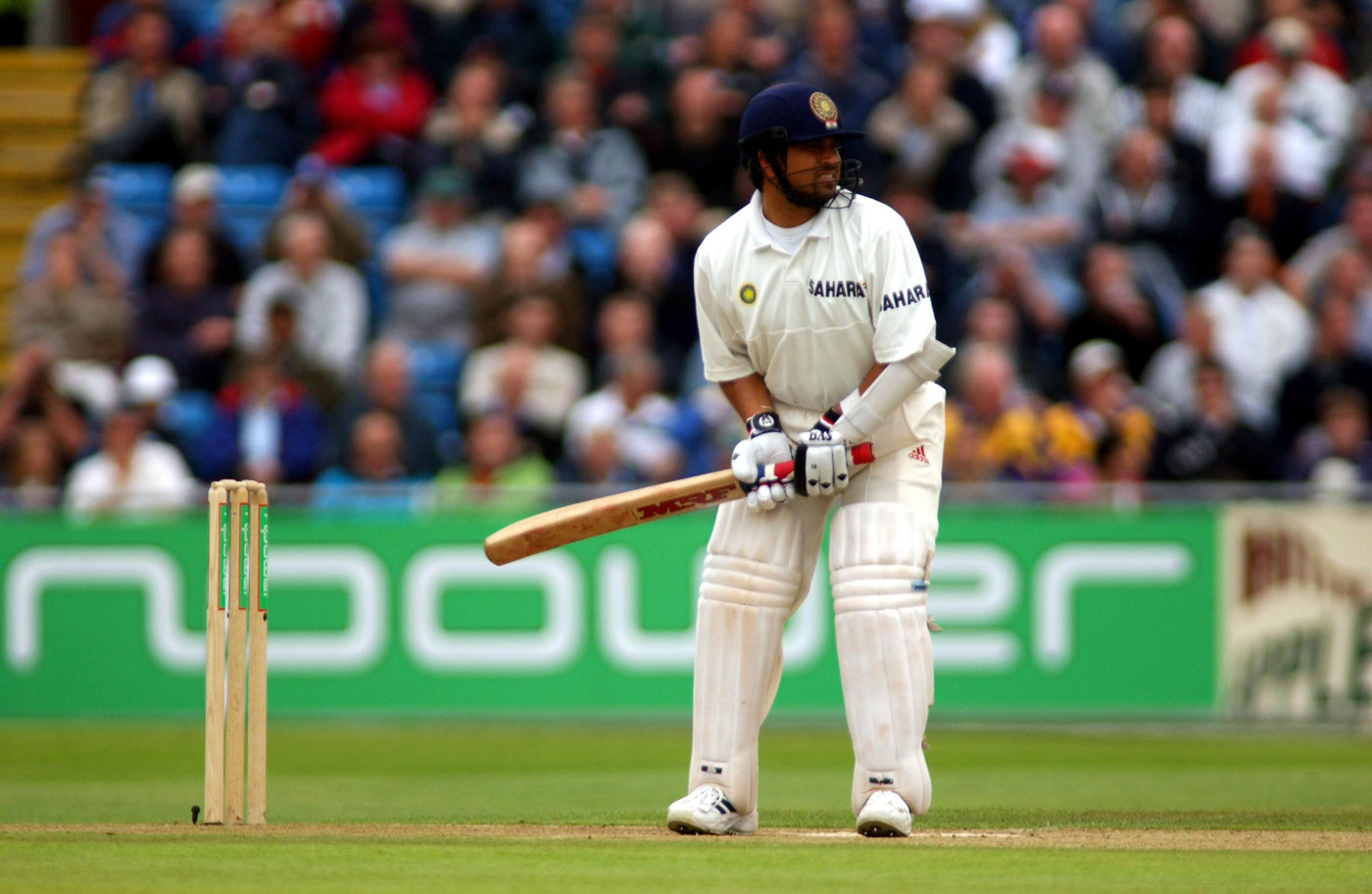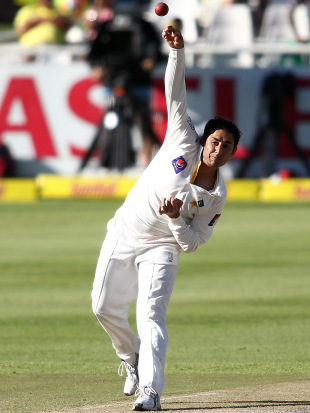
Sachin Tendulkar had the ideal natural stance: poised and ready to move © PA Photos
Every year, as I watch and marvel at the finest batsmen on view, new insights emerge. The art of batting provides subjects for a mighty debate. Allow me to share my latest observations.
The first advice I recall getting when I started as a lad was to line up "side-on" to the bowler, feet shoulder-width apart, shoulder tucked into the head, bat placed behind back foot. I was taught to get the front elbow up, and to play in the V. Everything was about hitting the ball, but I could only do it through mid-off, as that's where my body aimed. Today, batting successfully is, from a technical viewpoint, with the odd rare exception, really about one vital thing - footwork.
-----Also by Martin Crowe
To bat right get your mind right
----
Batting, in a nutshell, is about moving the body in reaction to a moving ball. Once in the right position, it is only then that relevance to hitting the ball applies, to stroke the ball into a gap in the field. The emphasis is to focus on what is required to execute proper movement to a moving ball. Therefore, the essential role of the stance is to be poised and ready to move athletically.
To move athletically, you must use your feet. To get the best out of your feet, the weight must be on the ball of each foot, for that is where the energy, the springy muscle, is, not the arch or the heel. Often the toes are referred to, yet it is in fact the ball of the foot, the round, sinewy area at the base of the big toe, that is the most vital part of the body when it comes to batting.
As you stand awaiting the bowler's delivery, the balls of the feet are priority, poised, ready to move quickly and efficiently. The best way to get on to the balls of the feet is to flex the knees. Straight legs send the weight to the wider part of the foot, including the heel, a sure way to slow movement. By flexing the knees and feeling the pressure on the balls of the feet, the body has its engine room fired up and ready to pounce. When I think of quick footwork I think of Don Bradman. He, better than anyone, showed that fast, efficient foot movements that facilitated getting into the correct body position was the key to batting.
What is the correct head position? In the modern day, with so much analysis, greater fitness levels, reverse swing and the 15-degree chucking toleration, it is critical for batsmen to play straight for long periods. Bowlers and coaches spend their time focusing on hitting the top of off stump. Therefore, more than at any time in history, I believe the position of the head has a key role in knowing where your off stump is at the moment the ball is released, aiding the ability to play pitch-straight.
It is my strong view that the outside eye (right eye for a right-hand batsman, left for the lefties) should be level with the other one and in a position to see the ball leave the bowler's hand, and not aiming at mid-off or looking over or past the nose to see the ball. The outside eye ensures the batsman is getting the best view of the ball release, knows where his off stump is, and provides an overall feeling of total balance and poise, allowing for the potential to play straight. This analysis of the outside eye is a lot different to the old days, when playing back was more the norm, mainly due to uncovered pitches and no protective equipment.
With the outside eye looking at the ball release, the shoulders will be slightly open towards the non-striker. As we work down the body, if the eyes are level as the ball is released, the hips will be slightly open also. From the hips to the flexed knees, to the weight on the balls of the feet, you have the ideal natural stance, poised, ready to move. Think Sachin Tendulkar.
At this point, with the body in the correct poised position, the bat can be placed into the mix. Imitating top batsmen who hold their bats aloft can be a dangerous exercise if not understood correctly. When the bat is positioned up high behind the body as the bowler runs in, there is potential for the hips, shoulders and head to all close off and for the outside eye to aim at mid-off. Also, if standing too tall, the weight can easily shift on to the heels. With respect, recall Nick Compton last year, when he was struggling. It is the balls of the feet that the weight must be on, not the heels; flexed knees, not straight-legged.
By holding the bat down low, with relaxed arms and soft hands, the bat has no influence on the ideal body position that has been set up. In fact, when the bat is held low, it encourages a slight crouch, enabling flex in the knees, weight on the balls of the feet. Often I see youngsters going into their stance with too much emphasis on holding the bat up high, not on getting ready to move. This is self-defeating because without the body moving into the correct position via the feet, the actual hitting will be flawed anyway.
Graham Gooch had a very effective upright stance, bat held high. Yet he had slightly open hips, eyes perfect, knees flexed, weight on the balls of his feet. He worked on this exhaustively. Those who copied him didn't work on the subtle yet important aspects of eye position, balls-of-feet pressure, and on retaining the ability to move quickly and freely, as Gooch did. For a big man who had obvious balance issues at times in his career, he carved out an amazing legacy.
There are many unique examples of how to bat well with different stances. AB de Villiers and Jacques Kallis provide examples of setting the stance nicely, with slightly open hips and front foot, bat held off the ground but not high, poised, ready to move. Virat Kohli stands with a great head position - quite tall, yet at the moment the bowler gathers, he flexes his knees enough to tap his bat and activate his ability to move. He is a wonderful example to all. Allan Border dipped his body at the last second to create flex in the knees.
The bat tap can be an important trigger for batsmen. It was for me. As I tapped the bat near my right foot, I felt the whole body spark into action. I once tried holding my bat up and couldn't get the same ready-to-move feeling. I preferred to flex and crouch a little. I liked the position of a boxer, of a tennis player. I marvelled at the stances of Don Bradman, Greg Chappell, Viv Richards, David Gower and Sunil Gavaskar, and the sublime movements they made. I liked, too, the way Javed Miandad stood at the crease, alert and ready. The best stance to spinners I have seen was his open one, suited to every possible line from well outside leg to well outside off. To see and then move accordingly.
| | | |
|
| It is the ball of the foot, the round, sinewy area at the base of the big toe, that is the most vital part of the body when it comes to batting |
|
| | |
|
And now for the most important part, the actual footwork needed to scoring runs, to staying long periods at the crease. Remember, the stance is set to know where the off stump is and to be poised to move. Then the ball is released and the eyesight picks up the movement of the ball. As it does, the brain sends a signal to the feet and body, to move. The key here is the plural: both feet. With all the best players, both feet are moving in some way, even subtly, to every ball they face. Even when they leave the ball, the best players will use both feet to ensure that they know fully where the ball is in relation to the stumps.
When a ball is full, the back foot loads up and activates the front-foot step. For Chappell, he expected the full ball, loading up the back foot in preparation. As the front foot steps forward, the back foot joins in on the fluent movement, coming up on to the toes, even off the ground, to assist in completing the whole body movement, and shot. Think a Chappell on-drive, with back foot flicked up to balance and complete the fluent front-foot shot.
The back-foot release, as I call it, is critical to every front-foot shot. For some strange reason, throughout New Zealand, coaching demands the back foot stays still, heel on the ground, for supposed stability. This only encourages a half body movement, forcing the hands and bat to take over prematurely, leading to all sorts of problems. This, in my view, is completely wrong and a real concern as I go around schools and clubs. A more important view is from Bradman himself, as shown page after page in his book The Art of Cricket. Every frame of footage of him shows both feet activated and fluent.
To play straight off the front foot, past the bowler, the back foot must play a part in aligning the whole body, aiming everything down the pitch and to complete the movement and straight stroke. As the feet and body work in unison in completing the positioning, the bat comes through straight and late - the best shot in the game. When the feet and body stop short of proper positioning, there are problems. For instance, when the back foot is rooted to the spot, the front-foot step falls short and often to the off side, encouraging the bat to come through early and mistime, often lifting, or with the batsman playing across his front pad.
When a ball is bowled short, the front foot quickly presses down, sending the back foot into position. As the back foot lands square to the wicket, the front foot releases onto the toe, or even off the ground out of the way, hips open, to ensure the entire body movement is complete and the striking of the ball is easy below the eyes.
The front foot plays a huge part in all back-foot play - often it is just about getting it out of the way of hitting the ball - and also in providing balance to the body as a shot is played. When you imagine a pull or cut shot, think Gordon Greenidge or Brian Lara; their front leg lifts up into a fully flexed position off the ground, as they swivel on the back foot, striking the ball with balance and full force.
To spin, the best players, like Michael Clarke or Miandad, use their feet at all times, either coming down to the pitch of the ball or quickly pressing off the front foot to score off the back foot. To defend a good spinner off the front foot, think of Ross Taylor, who uses the back foot to always align his body and his bat, to play pitch-straight, making the bowler field the ball.
Footwork, the use of both feet for every ball, is the absolute cornerstone of batting.


